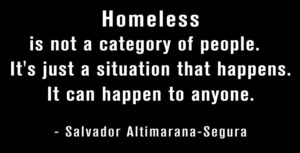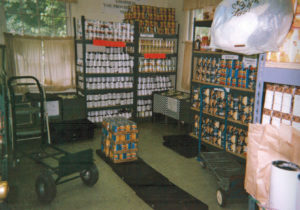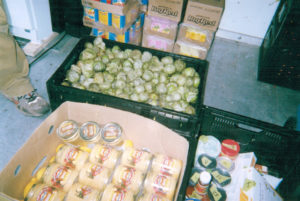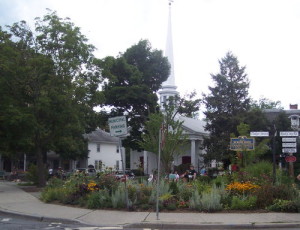My Story and the 9 Truths I Discovered
I began my life changing journey fighting hunger on a cool autumn Thursday in Woodstock, New York in 2005 where I volunteered for the first time at the local food pantry.
I was assigned a shift with Marie Duane. I drove over to the Woodstock Reformed Church, parked my car behind the buildling and cautiously walked in. I had never been to the pantry before.
I entered the empty hallway and found the pantry on the right. I walked into the room and there it was: a small space, actually, about 12′ by 16′. Each wall supported a set of metal shelving units. Each unit stood about 6′ high and 3′ deep with 4 shelves. Most of the shelves were empty. A few shelves had some food:
cereal
tuna
soup
peanut butter.
There was a little handwritten note in front of each display:
person: 1 item, family: 1 item.
There may have been other items on shelves but I don’t remember them.
A small table stood in the center of the room. A metal folding chair was placed in front of each window.
We sat in the chairs, Marie and I, and chatted as people trickled in. We discussed the usual: weather, gardening, knitting, decorating the alter at St. Gregory’s Episcopal Church.
“Hi. How are you? Will you please sign your name here?” Each shopper signed in and noted the number of adults, seniors, and children in the household. After signing in, the person walked around the room selecting from the cereal, peanut butter, tuna, and soup. The selected food was placed on the table and bagged to take home, wherever or whatever that was.
On this morning, not blessed with any psychic knowledge, I was totally unaware of experiences waiting for me in the pantry. Never in my wildest thoughts did I envision the hall filled with hungry people, the tiny room packed with fresh produce and jammed with shoppers.
Nor did I for 1 moment ponder the push back I would experience as the number of hungry seeking food grew. Within a few short years, this 2 dozen single homeless men – mostly Woodstock’s colorful characters – had swelled (due to a tanking economy) to over 300 people weekly. This number finally approached 500 people weekly before it was all over.
Now, in the autumn of 2015, our stock market experiences numerous “corrections”. I realize I learned some things over the years which, for me, are ground truths about the pantry.
Feeding the hungry with dignity is the most important thing.
Single homeless men are now far outnumbered by members of the Struggling Class, households of working people holding down 2 and 3 jobs just to pay the rent and buy the gas to get to work.
The 3 most hot button words in the English language are food, sex, and money. These 3 words are concerned with a person’s core beliefs, emotions, and spiritual attitudes. Food and money, or the lack thereof, loom large in pantries.
The sidewalks in our communities and cities have become wards of untreated mentally ill people. In our great nation we don’t hospitalize or otherwise treat many of our mentally ill. Instead, they they are incarcerated.
Some of these untreated mentally ill happen to be homeless. Homeless is not a category of people. It’s just a situation that happens. It can happen to anyone.
The 50+ senior population has many who lack enough $$$ for food and are largely a silent group. The bottom line is this: When our grandparents don’t get enough to eat, they often get sick.
I’m seeing a whole generation of children who have never been inside a grocery store.
Shoppers at our pantry can get a 3-day supply of food weekly. Their job is to make it last 7 days. Many share this food with a pet. Often, the only thing a person has left from a prosperous past is the dog.
The most difficult thing I see in the pantry is a Korean War vet getting food. Something I just can’t understand is how a person who served in a very brutal war, and subsequently spent an adult life working and paying taxes should have to be in a food pantry line in his old age.
Much of the food available to the hungry in food pantries is diverted from its trip to the landfill.
There is absolutely no excuse for anyone in our great nation to go hungry.
Thank you for reading this blog. The story is true. The people are real.
Please refer this article to your preferred social media network. Share this story with friends or relatives who might be interested.
Don’t forget to join the email list.
Thurman Greco
3 Important Things We Can Do To End 50+ Hunger
“Hunger and income inequality is probably the single biggest issue facing this country”. – Susan Zimet
Ending hunger is a huge task…so big it’s scary, even. But, it’s okay to be scary. It’s doable. And, besides that, anything that’s really important is probably a little scary. Right?
HOW CAN THIS HAPPEN?
Hunger in general and 50+ Hunger in particular are buried issues. In other words, unless you’re the one shopping at the pantry, you haven’t got much of a clue. If you’re standing in a grocery line with 5 cotton tops, statistics tell us that 1 of them is struggling for $$$ to get the food s/he needs.
Food insecurity happens with 50+ citizens when the retirement income is insufficient to meet day-to-day needs.
Not all 50+ people are retired. It’s not unheard of to see people visiting the pantry, men mostly, who have been fired from jobs they’ve held for many years. After a worker crosses the line to being 50+, getting another job is pretty impossible. So, the challenges are great. What I saw most of them do is desperately figure out how to get some sort of aid: SSI, disability, that will last until the social security kicks in.
I’VE SEEN MY SHARE OF MEN IN THIS STRUGGLE. Some were successful. Others just finally got seriously ill and died. This seems tragic, I know. But, think about it for a moment. What else are they going to do when the $$$ is gone and there is no chance of any more $$$ coming in?
One such pantry shoppers came into the basement of the Woodstock Reformed Church angry. He was one of the angriest men I saw in the pantry the whole time I worked there. Frightened reality covered his face.
“I’m finished” he said. “They fired me today! I’ll never be able to get another job again. I’m too old!”
I didn’t say a word. He didn’t look or act as if he was going to hurt anyone and I felt he needed to release some of his anger. He didn’t try to punch the walls or the other shoppers or the volunteers. And, since the wait was over an hour, I felt he would quiet down before he finished shopping.
HE WAS CORRECT ABOUT 1 THING. He was probably not ever going to get a real job again. I just hoped his unemployment was going to hold out until he could figure out how to get something more permanent:
SSI
Disability
SNAP
It took him a year to calm down. Every time he came to the pantry, I saw the anger. We all just left him alone. It was all we could do for him.
Time passed.
Now, in 2015, I saw him again – calm, maybe at peace with his situation. He lives in his truck, sort of semi homeless, I suppose. He has places to bathe, etc.
He’s a talented musician, this man. He has found places to play and he is looking okay. What more can we all ask for anyway?
Anyone with income that doesn’t include $$$ for food is, in my book, in crisis..
50+ seniors routinely decide between food and transportation, food and medicine, food and clothing.
WHAT CAN WE DO?
One thing we need to do is understand, really understand, what keeps seniors from getting enough healthy food. The 50+ population is growing, not shrinking. we have a continually increasing number of seniors facing
food insecurity
rising food costs
availability of healthy food
shrinking Government funding.
FOOD PANTRY WORKERS DO WHAT THEY CAN. Volunteers in many cases keep people from dying of hunger on the streets. But pantries are, with 50+ hunger, a small effort. Can people seek more important ways to address the problem? Can we develop some long-term and short-term solutions?
WE NEED TO DO 3 THINGS:
UNDERSTAND WHAT STANDS BETWEEN THE 50+ HUNGRY AND FOOD
EDUCATE THE PUBLIC
HELP THE 50+ POPULATION GET THE FOOD
Educating the public has its own challenges. Food is such a hot button issue in our country. People immediately go into denial. They want to believe that the shoppers in the pantry lines are all wealthy and drive Maseratis and Corvettes.
Of course, this will never be true. I’ve been working in the food pantry industry for 10 years and I’ve seen very few free loaders. And, honestly, the free loaders I met all had mental issues.
The number of people shopping in in food pantries who don’t belong is very small.
The number of people who need to shop in food pantries is large.
The number of 50+ people who need to shop in food pantries but don’t is way too large.
WE NEED TO KEEP THE EDUCATIONAL EFFORT GOING. That’s why I work in a food pantry, write this blog, and speak about hunger at pretty much any place I’m invited.
Helping the 50+ population get the food is a challenge. It’s difficult to learn that you worked all your life, paid your taxes, participated in social security, and now …when you need it…it’s not enough.
What happened to our dream?
Was it ever real?
Did we get bilked?
Were we all just kidding ourselves?
OUR PARENTS AND OUR GRANDPARENTS WORKED TO BUILD A NATION. We worked to continue the American Dream. Now, we find that it doesn’t really exist. For some, the belief is that this dream never did exist. For many, the most important thing is to just not let anyone know how bad things are for them.
Hunger in the 50+ community today is where being gay was prior to 2000.
If you can talk just one 50+ senior into getting SNAP, you will be doing a wonderful thing.
Thank you for reading this blog.
Please refer this article to your preferred social media network.
Don’t forget to join the email list.
Thurman Greco.
Supermarket Abandonment
Woodstock is a food desert. Hard to imagine, isn’t it? Woodstock lacking in anything. After all, 60% or so of Woodstock’s residents are weekenders with homes in the city. They venture up on weekends, hang out and entertain their friends with foods coming from the Sunflower, Sunfrost, the Cub Market. The main ingredient for their meat dishes most often comes from the well stocked Woodstock Meats.
But, what about the rest of the crowd who live here 7 days per week? The lucky ones with working automobiles shop at Hurley Ridge Market on 375 in Hurley, the Price Chopper in Saugerties, or one of the other chains in Kingston: Shoprite, Hannaford’s, Adams Fairacre.
Higher income locals also shop at the Sunflower, Sunfrost, Cub Market. Additionally, they shop in Saugerties or Kingston at Mother Earth’s.
These upscale shoppers, both locals and weekenders, focus their purchases on all natural, organic. Hudson Valley grown food. Popular buzz words are organic, non-GMO, Paleo, free range, antibiotic free, gluten free, hormone free, and…you get the picture.
Those who are not vegetarians or vegans also shop at Woodstock Meats and maybe at Adams Fairacre. The point here is that these shoppers participate in consumption trends associated with their lifestyle and health. And, with the upscale foods available in Woodstock, they’re able to get anything they want, whenever they want it.
The not-so-lucky live a different way. The Woodstock resident without a working automobile shops at the CVS, Rite Aid, Cumberland Farms.
The Woodstock resident without a working automobile gets Sunflower products by diving in the dumpster behind the store and by shopping at pantries located at Family of Woodstock, Holy Ascension Monastery, and in the Woodstock Reformed Church. Some homebound Woodstock residents benefit from Sunflower’s benevolency with produce and bread donated regularly to Meals on Wheels. These meals are delivered to their homes throughout the week for $3.00 per meal.
In years past, the Grand Union was extremely popular in Woodstock. Community groups held raffles, Girl Scouts sold cookies, and neighbors visited with one another while shopping. After snow storms, everyone went to Grand Union, shopped for milk, butter, and eggs, and swapped snow stories.
It was indispensable for the elderly and those without cars. In 2001, the Grand Union closed and CVS got the space. In typical Woodstock fashion, residents took to the streets with demonstrations. But, it was to no avail. On April 11, 2001, Woodstock became a food desert.
The result? Many local people walking on the sidewalks of Woodstock today don’t have enough $$$ to purchase a sufficient supply of nutritious food. Food insufficiency is also known as food insecurity. More people than we realize deal with this situation on a daily basis.
Without access to nutritious food, they suffer from overconsumption. When a person eats too much of the wrong thing and too little of the right thing, hunger, poverty, and diseases such as diabetes overlap and connect.
For those of you who believe the fault is entirely that of the hungry, poverty stricken person: please remember that the community is as much to blame as the individual. People eat what they have access to. They don’t eat what they can’t get. Less prestigious stores in Woodstock offer too few choices of healthy and affordable food. They offer packaged food rich in fat, sugar, salt, preservatives, artificial coloring, artificial flavoring, pesticides.
As the wealthy and privileged shop for the best available food and adapt the latest food and health trends to their diets, the lower, less privileged class is left further and farther behind. They will probably never catch up.
Thank you for reading this blog/book.
Please share this article with your preferred social media network.
Please leave a comment.
Don’t forget to join the email list.
Peace and food for all.
Thurman Greco
The Inquisition – Food Pantry Meetings in Upstate New York
“We came closer to understanding the crazy circus logic of the witch-hunt that began.” – Kathy Bates
What a year! 2011 began with Gabrielle Giffords being shot in the head. Gaddafi was killed. Hosni Mubarak was forced from power. Osama Bin Ladin was killed. Hurricane Irene left destruction still not repaired. Our country entered its 10th year in Afghanistan, and unemployment hit 9%.
Meanwhile, in Woodstock, I remember 2011 as the year the building committee
Tried, really tried to get rid of me
Tried, really tried to return to the pre-2008 glory days of 25 shoppers a week
Tried, really tried to get rid of the cardboard
Tried, really tried to get rid of the fresh produce
Tried, really tried to reduce the pantry footprint by reducing the hours available to the volunteers
Tried, really tried to reduce the pantry footprint by reducing the number of volunteers permitted in the pantry at any given time
Tried, really tried to restrict the shoppers’ and volunteers’ access to the parking lot
Tried, really tried to get control of the money that was coming in to the pantry from donations.
THE INQUISITIONS
They hosted several Inquisitions in July, August, and September to address their displeasure with everything they could think of, item by item. These meetings were attended by Ed Jabbs, Stewart DeWitt, and Barbara Moorman from the building committee. Pastor Bode attended the meetings also. Hatti Iles, Ann King, Mike Lourenso, Marilou Paturel, Karen White, and Jim Dougherty represented the community. I was only allowed to attend because, as the coordinator, I knew a lot about things that were going on which absolutely no one else knew. For starters, I knew the HPNAP rules and the Food Bank guidelines.
We all crowded around a large table in the corner room adjacent to the storeroom. Ed Jabbs sat at the head of the table with the posture of judge and jury. During the meetings he did all the talking for the building committee.
Barbara Moorman and Stewart DeWitt, building committee members, never uttered a sound unless he asked one of them a question. Two building committee members did not attend these meetings: Roger Shultis and Mike Cooter. Too bad for them because these two guys really couldn’t stand Thurman Greco and They would have love, love, loved to have been there. I never quite figured out why they weren’t included.
Certainly Roger Shultis knew a lot about the pantry activities. He spent pantry days in the hall watching everything with a scowl on his face.
Hatti Iles was the spokesperson for the community. Hatti is a local artist, very talented and well known. She practices martial arts, teaching Tai Chi in town. Hatti was very grounded when the situation got aggressive.
Thurman Greco was identified in all cases by Ed Jabbs as the main culprit in all complaints.
THE FIRST INQUISITION
Huge on the agenda at the first inquisition in July was rot and vermin mitigation. They didn’t want produce because it brought bugs, rot, vermin, and cardboard. We had long discussions in which the building committee members discussed their opinions that all the produce coming into the pantry from whatever source was rotten.
Our response was that the produce came from the Food Bank in pristine condition and would not rot if kept cool. Which brought up yet again the problem that we needed more refrigerators which were never going to be admitted in the building: never, never, never. The fact that the Meals on Wheels kitchen across the hall from our pantry had several refrigerators and freezers was not even considered.
The pantry was not, ever, going to get more appliances.
The unspoken words: “We don’t want the pantry feeding this kind of food to these people. The unworthy hungry should go to Kingston. We’re going to do everything possible to stop the escalation of the shopper census. We’re going to do everything possible to reduce the pantry to the point where it’s serving 25 people per week again. You have ruined our pantry.”
The fact that there were no bugs or mice in the food was of no consequence. The presence of produce and cardboard invited these vermin and no argument was able to overcome their stand. Facts had no weight in this inquisition. They just didn’t want me in the pantry at all.
The building committee insisted that we store the produce in plastic bins with tight fitting lids. They demanded that the food be removed from the building on Thursday at the end of the pantry week.
Removing the food on Thursday at the end of the pantry week was certainly fine with me. We were taking the leftover produce to Family and then to the Woodstock Farm Animal Shelter.
Storing the produce in plastic bins with tight fitting lids was not. When produce is stored in airtight plastic bins, it can’t breathe. This speeds up the rotting process. However, I had to do this if I wanted the pantry to remain open.
To make their point, a church member went to Target and bought four of the largest plastic bins he would find to the tune of $150. These bins appeared in the pantry storeroom complete with the receipt for reimbursement. These bins were so large that, when filled with produce, they couldn’t be lifted by the volunteers.
The building committee digressed from the vermin/cardboard issue at the first meeting to establish that the pantry was renting the space by the hour and the value of the space is $20 per hour. We were paying a nominal sum for the rent: $1000 per year. The issue was that everyone needed to be clear that we weren’t paying our “freight”, as my grandmother in Texas would have said. Nothing was ever mentioned about the fact that, for years, the pantry had paid nothing for the space. I had begun to pay the church for the space because I felt the pantry needed to offer money to cover costs such as painting the walls, cleaning the bathrooms.
Offering the church money for the space was a seriously bad idea. We ended up cleaning the bathrooms ourselves and paying to paint the walls. The building committee resented the money because of the amount given.
THE AUGUST INQUISITION
The August inquisition moved right along to insurance issues, fire codes, inspections from the Food Bank, restriction of volunteer access to the building, pantry volunteers trying to identify who was breaking in the pantry and stealing food.
“We spoke with our insurance agent and you need liability insurance with the church co-named. We need a policy in our hands by Monday.”
“This is Thursday afternoon. It’s 4:00 and our meeting isn’t even over yet. How can we do this by Monday?”
“Well, you better do it or your pantry is out of the building. I realize this is problematic for you but we spoke with our insurance agent and this is what we need.”
AND
“We need a fire inspection of the building. We want to make sure your volunteers aren’t breaking any rules in the pantry. Your tables, chairs, and all those people in the hallway are a fire hazard. All those cans and boxes and all that produce might be a fire hazard.”
AND
“There are far too many chairs in the hallway. We don’t want more than three or four chairs in the hallway. Right now you have the hallway lined with chairs for the shoppers. This is a safety hazard.”
AND
We want to know when anyone is in the building. Anytime a Food Bank person is in the pantry, we need to know about it. We want to see copies of all of your inspection reports.”
“I’ll be happy to show you the inspection reports except that I’m not permitted to. The Food Bank considers that information to be confidential. Actually, I’m very proud of those reports. I get the highest score possible on all the inspections.” I used this moment to proudly describe the details of every inspection we’d had, including the surprise visit from the USDA. I was then, and still am, very proud of how our inspections went. I always got top grades.
AND
“We saw a police car outside the pantry yesterday. It wasn’t even pantry hours. What’re you doing?” Jabbs’ voice was raised.
“We’re trying to find out who’s been stealing food from the pantry and the storeroom while the pantry is closed.”
“How dare you call the police! You have no authority to call the police! This building is ours! We decide who calls the police!”
“Well, we have to find out who’s been stealing food. Someone is coming into the pantry and stealing food.”
“No you don’t! If we see a police car here again, you’re outta here!”
For months I had noticed food disappearing from the pantry when it was closed. I tracked the disappearances. Most of the time someone was coming in and getting a can or jar or two. Then, things escalated a bit. One Tuesday, I came in the pantry to find nine cans of green beans missing. Another time I came in to find several jars of peanut butter missing. The culprit had a sense of humor. An empty jar of peanut butter was left as a calling card.
The final issue was the restriction of hours and volunteers. We were told to have fewer volunteers during pantry hours and to be in the pantry only during certain times on specific days.
We never brought up the subject of the food thefts again. We felt if we did that the pantry would be shut down because the only way a person could get into the building, then into the pantry, and remove food repeatedly without damaging the doors, and locks, was by having a key. That made the thefts an inside job. The building committee members all had keys to the pantry rooms.
Our accusations were too close for comfort.
SEPTEMBER BROUGHT THE FINAL INQUISITION.
The agreement that resulted from these meetings brought many changes:
Tuesdays we were allowed in the building from 9:00 a.m. until noon to stock shelves.
Tuesday afternoons were available to selected volunteers to prepare take out bags.
On Wednesday mornings, we could bring in produce from 11:30 to 12:30. We then had to vacate the building until 3:00 p.m. when we could reenter to operate the pantry until 7:00.
Thursdays we were in the building from 2:00 p.m. until the pantry closed at 5:00. We were required to be out of both the building and the parking lot by 6:30 p.m.
On Fridays I was allowed to bring in a small shipment of canned/boxed goods at some point between 4:00 p.m. and 6:00 p.m. for no more than thirty minutes. I was not allowed to put any products on the shelves.
No food was allowed to be distributed from the hallway on pantry days.
No more than three chairs were allowed in the hallway.
Our shoppers were not allowed to use the handicap restroom.
On one was allowed to lean on or touch the walls.
No one was allowed to sit on or go up or down the foyer stairs. No one was allowed in the foyer at all except to walk through to the hallway.
Nothing was allowed in the entrance foyer or on the stairs.
We had permission to use the length of the hallway. We weren’t allowed to use the hallway from the point it turned toward the remainder of the church.
Church member volunteers were in the building when we were allowed to operate the pantry. They watched activities making sure we didn’t break rules. Some watchers were discreet. Others were obvious, in our faces. One walked up and down the hall, the parking lot and the entrance yard taking photographs and continually talking on the phone to others relaying all of the things we were doing. I was always protective of the shoppers where photographs were concerned but when this happened, I simply did nothing. The situation was too confrontational.
Anyone using the church bathroom (not the handicap bathroom) was to be supervised by a pantry volunteer.
Any pantry inspections required prior notification to the building committee.
The building committee wanted copies of all our paperwork. The building committee wanted to know about every grant received.
I was allowed to store records in the storeroom but not allowed to have an office or perform any administrative functions.
It was good the meetings ended when they did because in July I was a totally upset sweet little old lady trying very hard to do what the Food Bank and the HPNAP people wanted. By September I was eating nails. My attitude was that I would continue to do what the Food Bank and HPNAP wanted and would not provoke the building committee. I followed their rules and promised myself that when “the fat lady sings”, so would I.
I had returned to my Texas roots. My motto was this: “I don’t start the fight but I’ll damn sure finish it.” My family came from very tough stock. We were some of the first settlers in America and then in Texas. My Grandmother was a Deputy Sheriff in Edwards County, Texas, and my father was an attorney who used the word “ethical” everytime he used the word “legal”.
I emerged from the Inquisitions with a mission statement: to inform people about hunger in America by writing about food pantries in articles, a blog, and books. I would produce a TV show on public access TV and put the material on You Tube.
2011 was the pivotal year.
Thank you for reading this blog/book
Please post this article on your preferred social network
Please send a comment.
Peace and food for all.
Thurman Greco














